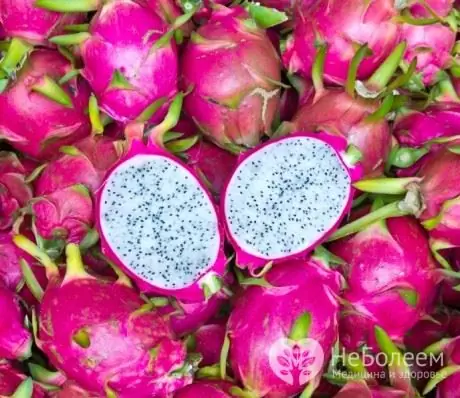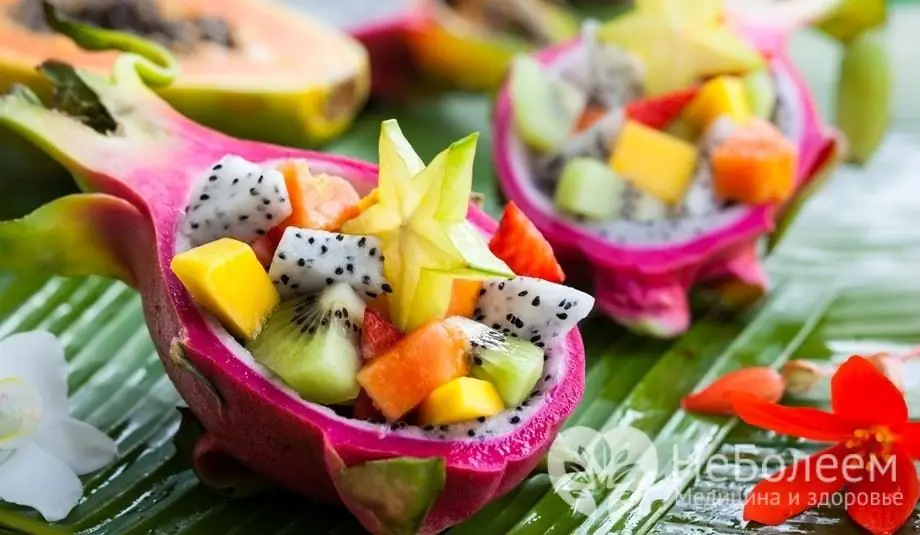- Author Rachel Wainwright [email protected].
- Public 2023-12-15 07:39.
- Last modified 2025-11-02 20:14.
Pitahaya
Pitaya (pitahaya) is a tree-like bushy cactus with juicy fruits at the ends of the stems. Fruits of different types of cactus differ in size, pulp color, surface smoothness. All pitahaya fruits have a large number of black seeds.
The ratio of BJU in the product

Source: depositphotos.com How to burn 40 kcal?
| Walking | 10 min. |
| Jogging | 4 minutes |
| Swimming | 3 min. |
| A bike | 6 minutes |
| Aerobics | 8 minutes |
| Household chores | 13 minutes |
The homeland of the pitahaya is the Western Hemisphere. The first mention of this exotic fruit dates back to the thirteenth century. The sour and sweet fruits of the pitahaya were popular among the Indian tribes who lived in the territory of modern California. The redskins ate the pulp, and the seeds were fried, ground and used to make stews.
Now it is grown in Israel, in some countries of South and Central America, in Mexico and Vietnam.
There are three main types of pitahaya - yellow, red and Costa Rican. The skin of the red fruit is red-pink and the flesh is white. The Costa Rican pitahaya has red skin and flesh, while the yellow fruit has yellow skin and white flesh. Yellow fruits are considered the sweetest with a rather strong odor. The taste of red pitahaya is rather bland, and the aroma is light and herbal. In appearance, "dragon fruit" (the second name of pitahaya) resembles a small pineapple. Its weight ranges from 150 to 750 grams. The pulp of the fruit is similar in consistency to sour cream, and in taste it vaguely resembles kiwi and banana.
The composition of the pitahaya
The beneficial properties of pitahaya are explained by the high content of nutrients. Its pulp contains water, carbohydrates, and a small amount of polyunsaturated fats. "Dragon fruit" is considered a good source of natural antioxidants, vitamins B1, PP, B3, B2 and, especially, dietary fiber, phosphorus, calcium, iron and other minerals.
The calorie content of the fruit is 50 kcal per hundred grams of the product.
Useful properties of pitahaya
The properties of pitahaya make it a valuable dietary product. This fruit boosts immunity, lowers the level of bad cholesterol in the blood, and improves the functioning of the digestive tract.
The fruit is also believed to have a beneficial effect on the quality of vision.
The beneficial properties of pitahaya are used by chefs and cosmetologists. This fruit is added to sweets, sorbet, ice cream, yoghurts. Jam and jelly are made from its pulp. The fruit retains all its properties in combination with hibiscus, pear, sandalwood, musk, jasmine. Almond and pitahaya dish is very popular in Central America.
In cosmetology, this fruit is added to creams, shower gels.
How to eat pitahaya
How is pitahaya eaten? It can be consumed in its pure form, as well as used for making desserts and cocktails.

Usually the fruit is cut into two halves and the flesh is eaten with small spoons. You can also cut it lengthwise, getting two equal parts, which in turn cut into slices, as is done with watermelon and melon. Do not eat pitahaya skin. Chill it before serving. Dragon Fruit does not go well with food that has a strong taste.
Often, pitahaya is used to make low-alcohol drinks. In Spain, pitahaya juice is mixed with lime (lemon) juice. Shrub flowers are also suitable for food. They are added to tea to create a sophisticated aroma.
YouTube video related to the article:
Found a mistake in the text? Select it and press Ctrl + Enter.






